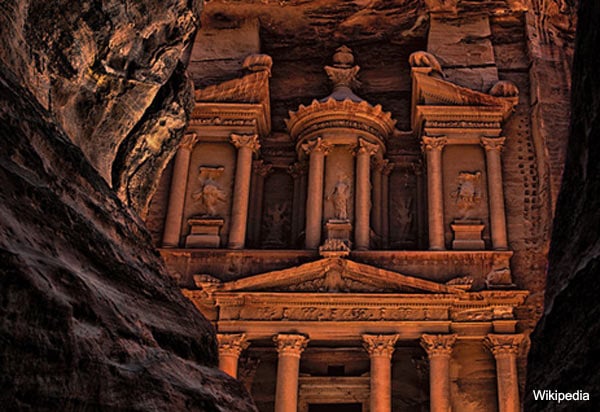Ancient monuments of the Nabataeans were built according to celestial events
A study published in March by the Nexus Network Journal suggests that the spatial position of palaces, temples, and tombs built at least 2, 300 years ago by the Nabataeans, including the famous city of Petra, were determined by the movement of the Sun and other astronomical events.
The research was carried out by scientists from the Instituto de Astrofisica de Canarias (IAC) and the Instituto de Ciencias del Patrimonio, Incipit (CSIC) in Spain, and the University of Perugia, Italy. Using statistical analysis on the spatial position of significant ancient monuments built by the Nabataean people, the results suggested that the great buildings are linked with the equinoxes, solstices, and other astronomical phenomena.
"The Nabataean monuments are marvellous laboratories where landscape features and the events of the sun, moon and other stars interact," said Juan Antonio Belmonte, researcher of IAC and coordinator of the study. "The astronomical orientations were often part of an elaborate plan”.
The enigmatic Nabataeans were originally a nomadic tribe, but about 2,500 years ago, they began building great settlements and cities which prospered from the first century BC to the first century AD. As well as their agricultural activities, they developed political systems, arts, engineering, stonemasonry, and demonstrated astonishing hydraulic expertise, including the construction of wells, cisterns, and aqueducts. Now it appears they were also master astronomers.
They expanded their trading routes, creating more than 2,000 sites in total in the areas that today are Jordan, Syria and Saudi Arabia. Archaeologists are still trying to unravel the history of the Nabataeans, which in large remains unknown. Just how they managed to make the rapid conversion from a Nomadic tribe to the builders of great cities is mind-blowing.
One example of a monument built based on celestial events is seen at Ad Deir, the Monastery at Petra. During the winter solstice, the light of the setting sun enters through the gate of the monument and illuminates the sacred motab, a podium where some stone blocks representing divinities, such as the god Dushara, are placed. But that is not all it does, another incredible event takes place in that moment. The setting of the sun recreates the aspect of the head of a lion, the animal of the Nabataean goddess Al Uzza, on the opposite rocks.
Mathematical calculations have also demonstrated that the Urn Tomb, a famous monument where king Malichus II is thought to be buried, follows an astronomical plan. Its main gate is centred with its environment according to the equinox sunset, when the day equals the night, and the solar rays during the summer and winter solstices establish the two interior corners of the building.

The Urn Tomb. Photo credit: Wikimedia
"We consider that it is a deliberate attempt to convert the hall of the Urn Tomb into a type of time-keeping device," said Belmonte.
The study authors concluded that the awe-inspiring ancient monuments of the Nabataean culture demonstrate that astronomical features were a “substantial element in Nabataean religion” and reveals “new evidence for cultic worship centred on the celestial sphere”.
Journal Reference:
Juan Antonio Belmonte, A. César González–García, Andrea Polcaro. Light and Shadows over Petra: Astronomy and Landscape in Nabataean Lands. Nexus Network Journal, 2013; 15 (3): 487 DOI: 10.1007/s00004-013-0164-6
Featured image: Ad Deir, the Monastery at Petra. Photo credit: Wikimedia




















Comments
Many studies have confirmed astronomical alignments in hundreds if not thousands of ancient monuments, so this "revelation" regarding Nabataean buildings shouldn't surprise anybody. In ancient times, astronomy and religion were much more integrated into everyday life than nowadays, according to my reading over the years. So it's natural for early builders of cities to focus on alignments with celestial events. I'd be surprised if there were any ancient cities that *didn't* have such alignments. We've even done it ourselves with "Manhattanhenge."
This article states "Mathematical calculations have also demonstrated that the Urn Tomb, a famous monument where king Malichus II is thought to be buried, follows an astronomical plan" but doesn't say who did the calculations and when. I'd like to know.
Spend any time there, and the position of the temples, the way they face, and their positions are ALL entirely determined by the direction that the cliffs they are carved into face. This being so, any skilled architect can obviously take advantage of the site to bring into their carved out spaces the best illumination possible- and that means maximizing the light for the shortest day of the year. Any tricks of the light that result are a bonus, but nothing compared to what Petra can offer the sincere visitor
The carved stone buildings of older cultures are so amazing to me, the craftsmanship is just exquisite. It would have been special to witness these cultures in their peak.